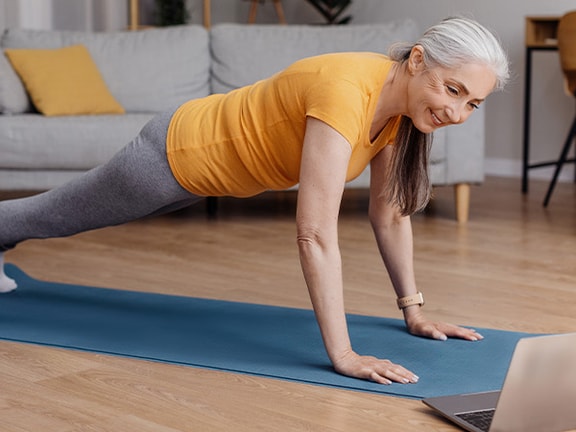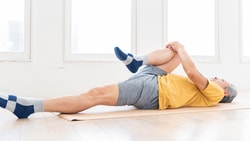The Transformative Power of Exercise: Insights for Physical Therapists
Exercise is a powerful tool for recovery, resilience, and lifelong health. Learn how to help patients harness movement for lasting well-being.
February 5, 2025
10 min. read

As a physical therapist, I’ve seen firsthand the transformative power of movement—patients overcoming pain, regaining mobility, and reclaiming their lives through purposeful exercise. Yet, the benefits of movement extend far beyond rehabilitation, pushing us to elevate overall wellness and resilience.
Achieving optimal wellness creates a buffer of functional reserve, making us more adaptable and resilient to injuries or setbacks. Exercise is a cornerstone of both physical and mental health, a powerful force that strengthens the body, sharpens the mind, and uplifts the spirit.
Movement isn’t just recovery—it’s a lifelong tool for thriving. In this article, I’ll discuss how you can leverage exercise to empower your patients, enhance their outcomes, and inspire lasting change. From understanding the physical and mental benefits of movement to integrating sustainable exercise habits into your care plans, this guide will equip you with tools for meaningful impact.
Physical health: The foundation of longevity
Exercise is the core of physical health, acting as the engine that propels the body toward resilience and vitality. It strengthens the heart, improves circulation, and reduces the risk of chronic diseases such as diabetes, hypertension, and obesity. Regular movement fortifies bones, enhances joint flexibility, and boosts muscular strength—all critical components for maintaining independence as we age.
Importantly, exercise also fuels our immune system. Studies show that moderate-intensity physical activity increases the circulation of immune cells, helping the body fend off illnesses. This simple yet powerful mechanism reinforces the idea that exercise is not just about recovery—it’s an investment in long-term health and quality of life.
Mental health: A gateway to emotional resilience
Exercise is as vital for mental well-being as it is for physical health. Regular physical activity reduces symptoms of anxiety and depression by triggering the release of endorphins—our body’s natural mood elevators. Beyond that, exercise sharpens cognitive function, enhances memory, and improves focus while reducing the risk of neurodegenerative conditions like Alzheimer’s disease.
The mind-body connection is undeniable. Movement encourages mindfulness, a practice of being present and attuned to one’s physical sensations, which can ease stress and improve overall quality of life. Whether it’s a brisk walk in the park or a high-intensity workout, exercise creates space for mental clarity and emotional stability. By framing movement as a pathway to resilience, you can inspire your patients to embrace habits that support body and mind.
The power of community: Motivation, accountability, and support
Movement takes on a new dimension when done in a community, transforming it from an individual effort into a shared journey. Exercising with others fosters motivation, accountability, and a sense of belonging, making fitness more enjoyable and meaningful. A supportive group environment not only enhances the likelihood of reaching fitness goals but also helps create sustainable habits that enrich overall well-being.
Here are five benefits of exercising within a community:
Motivation and encouragement: Being surrounded by others with similar fitness goals can provide inspiration and perseverance to push through challenging workouts.
Accountability: Group settings naturally foster consistency, as individuals are more likely to stick to their exercise routines when progress is visible and shared among peers, creating a sense of mutual responsibility and support.
Social connection: Exercising alongside friends or like-minded individuals creates a sense of camaraderie, making the experience enjoyable and emotionally fulfilling.
Shared experiences: Being able to share challenges and successes with others in a similar situation can provide valuable support and understanding.
Variety and new skills: Communities often offer diverse exercise options, such as classes, group challenges, or team-based activities, introducing participants to new exercises and skills that keep workouts engaging, stimulating, and enjoyable.
Encouraging your patients to join or create an exercise community can help them achieve their fitness goals and enrich their overall wellness journey, reinforcing the idea that health is a collaborative and dynamic pursuit.
The role of healthcare providers: Proactive and impactful approaches
As healthcare providers, we have an obligation to champion proactive and evidence-based approaches to well-being. Reactive care alone is no longer sufficient to address the complex health challenges you, me, and our patients face. Instead, we must advocate for strategies that prevent illness and enhance quality of life—and exercise is among the most impactful tools in our arsenal.
If exercise were a drug, it would be considered the ultimate "wonder drug" and fountain of youth, offering unparalleled benefits in reducing all-cause mortality and improving overall quality of life. Patient education is key to unlocking these benefits. Teaching patients about the advantages of exercise and tailoring interventions to their specific needs empowers them to take ownership of their health.
From teaching proper lifting techniques to designing personalized home exercise programs, our role extends beyond treatment; it is about empowerment. Incorporating lifelong exercise principles into your rehab program is a simple way to start. When educating, start small with those who have the furthest to go! We should encourage small, sustainable changes—walking more, standing frequently, or incorporating strength exercises—that add to significant health gains over time.
Challenge yourself:
Are your patients still using those light dumbbells and bands as they approach discharge?
Are you challenging your patients adequately for the demands of life?
Have you helped set them up for success in continuing a lifelong relationship with exercise?
Encouraging patients to think beyond immediate recovery opens the door to greater health and resilience. It also positions you as not just a provider but a partner in their journey to better health.
Markers of fitness: Indicators of health
So, how do we measure health in a practical sense? Beyond traditional metrics like weight or BMI, functional markers offer a more dynamic and comprehensive view of fitness. These markers not only help you set meaningful goals for your patients but also provide a clearer picture of overall health and progress:
Cardiovascular endurance
Assessed through activities like walking, running, or cycling, endurance reflects heart and lung efficiency. It’s a critical indicator of overall vitality, directly influencing an individual’s ability to perform daily activities and recover from physical stress.
Bike test: The test (fully described here) started with a power output of 50 watts (W) that was raised by 50 W for men and 25 W for women every fourth minute until the test was stopped. Exercise capacity is calculated as the mean (W) of the last four minutes of exercise workload.
Men: Maximal workload of less than 162 watts was associated with a four times increased risk of cardiovascular death.
Women: Maximal workload of less than 100 watts was associated with a five times increased risk of cardiovascular death.
Muscle strength
The ability to perform resistance-based movements—from weighted squats to push-ups—demonstrates robust musculoskeletal health and is crucial in maintaining functional independence as we age. Stronger muscles support better posture, joint stability, and the ability to manage physical demands, reducing the risk of injury.
Grip strength: A reliable predictor of overall strength and a strong correlate of cardiovascular health and longevity. Studies show a near-linear inverse relationship between grip strength and all-cause mortality.
Knee extension strength: Research reveals that individuals with higher knee extension strength experience a 14 percent lower risk of death, highlighting its importance as a functional and longevity marker.
Flexibility and mobility
Flexibility is essential for joint health, injury prevention, and maintaining an active lifestyle. Tests like the sit-and-reach can measure flexibility by assessing the range of motion in major muscle groups. Improved flexibility allows for smoother, more efficient movement, reduces stiffness, and promotes better posture, making daily activities more manageable and comfortable. Encourage patients to add regular stretching or mobility exercises to their routines to maintain independence, prevent overuse injuries, and improve overall physical resilience.
Balance and coordination
Balance and coordination are crucial for preventing falls, particularly in older adults, where losing these abilities can significantly impact independence and quality of life. Training coordination and learning new tasks can be valuable endeavors for both old and young alike, as they help to keep both the mind and body agile.
Research highlights that simple balance assessments can effectively identify individuals at higher risk for injurious falls. For example, the inability to stand unassisted on one leg for at least five seconds has been shown to double the risk of injurious falls in older adults.⁵ These assessments are valuable tools in fall prevention strategies, providing actionable data to address deficits early.
Risk indicators for falls:
Tandem stance hold: Less than 10 seconds
Single-leg stance (SLS): Less than 5 seconds
These markers provide a clear roadmap for setting fitness goals and tracking progress, reinforcing the notion that health is multifaceted and dynamic.
Inspiring change through movement
Exercise is more than a tool for physical transformation; it is a key to unlocking our fullest potential. As healthcare providers, we are responsible for guiding our patients toward a lifestyle that embraces movement, resilience, and vitality. By focusing on the profound benefits of exercise and the markers of true fitness, we can inspire meaningful change—not only in individual lives but in the health of our communities as a whole. Let’s move forward toward a healthier, more vibrant future.
Do you feel confident coaching patients through functional strength movements? Check out my Functional Strength Training course for insights on movement breakdowns, alternative exercises, and dosage strategies.
References
Nieman, D. C., & Wentz, L. M. (2019). The compelling link between physical activity and the body's defense system. Journal of sport and health science, 8(3), 201–217. https://doi.org/10.1016/j.jshs.2018.09.009
Korpelainen, R., Lämsä, J., Kaikkonen, K. M., Korpelainen, J., Laukkanen, J., Palatsi, I., Takala, T. E., Ikäheimo, T. M., & Hautala, A. J. (2016). Exercise capacity and mortality - a follow-up study of 3033 subjects referred to clinical exercise testing. Annals of medicine, 48(5), 359–366. https://doi.org/10.1080/07853890.2016.1178856
Silva, L. F., Matos, C. M., Lopes, G. B., Martins, M. T., Martins, M. S., Arias, L. U., Pisoni, R. L., & Lopes, A. A. (2011). Handgrip strength as a simple indicator of possible malnutrition and inflammation in men and women on maintenance hemodialysis. Journal of renal nutrition : the official journal of the Council on Renal Nutrition of the National Kidney Foundation, 21(3), 235–245. https://doi.org/10.1053/j.jrn.2010.07.004
García-Hermoso, A., Cavero-Redondo, I., Ramírez-Vélez, R., Ruiz, J. R., Ortega, F. B., Lee, D. C., & Martínez-Vizcaíno, V. (2018). Muscular Strength as a Predictor of All-Cause Mortality in an Apparently Healthy Population: A Systematic Review and Meta-Analysis of Data From Approximately 2 Million Men and Women. Archives of physical medicine and rehabilitation, 99(10), 2100–2113.e5. https://doi.org/10.1016/j.apmr.2018.01.008
Vellas, B. J., Wayne, S. J., Romero, L., Baumgartner, R. N., Rubenstein, L. Z., & Garry, P. J. (1997). One-leg balance is an important predictor of injurious falls in older persons. Journal of the American Geriatrics Society, 45(6), 735–738. https://doi.org/10.1111/j.1532-5415.1997.tb01479.x
Below, watch Elizabeth Lane discuss the benefits of functional strength training in this brief clip from her Medbridge course "Functional Strength Training."






